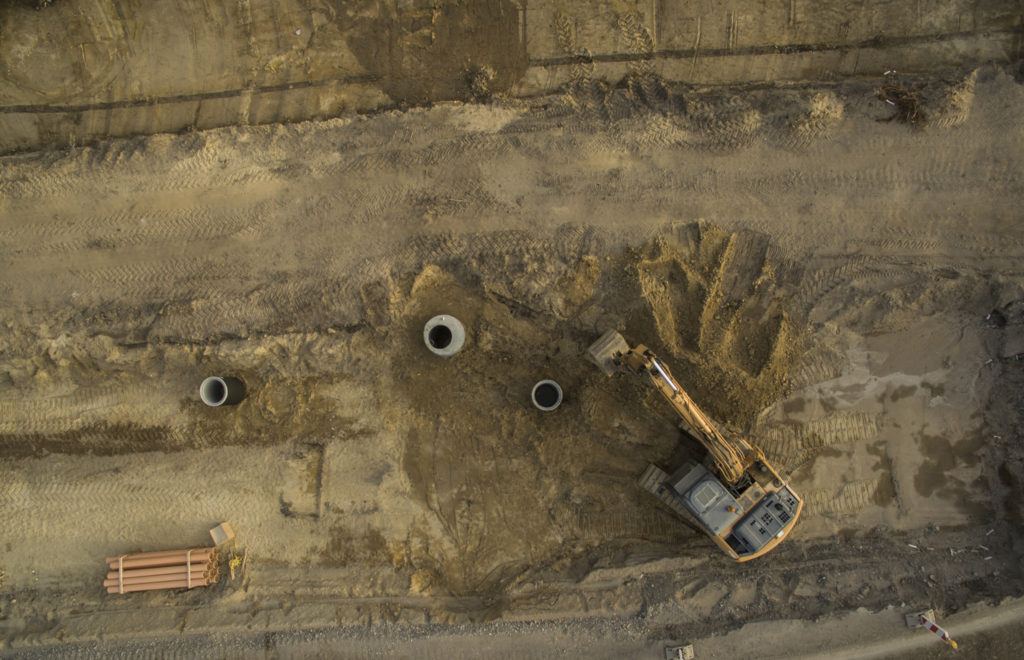Excavation and Earthwork Safety
Considerations for SWPPP Compliance
The construction stormwater permit requires the developer or contractor to ensure two things. First, that subcontractors or other outside service providers understand and follow the requirements found in the construction permit and the site’s SWPPP. And second, that the subcontractor follows the stormwater requirements.

The municipality is required to assure the contractor stays in compliance with the stormwater requirements of the permit. If the municipality or the contractor fails to comply with the regulations, it can result in non-compliance actions or fines for the city and the contractor, including a shutdown of the project.
You should refer to the SWPPP map to see where all BMPs are supposed to be. These controls are designed to prevent sediment and pollutants from leaving the construction site. You can ask the project manager or site superintendent for a copy of the map if you need one. Here are examples of controls you may find on the SWPPP map:
- Perimeter Controls. When performing excavation and earthwork, the perimeter controls on the SWPPP map ensure that sediment does not leave the construction site. Examples include silt fence, straw wattle, and cutback curbs.
- Stockpiles. Stockpiles need to have controls if they are going to be on site for more than a couple days or if it will rain soon. They must be placed on pervious surfaces and out of the street. Stockpiles that are not being used must have a control on the downslope side to contain the stockpile from washing across the site. To prevent dust stockpile height must be reduced where possible. They should also be covered, vegetated, tackified, or sprayed regularly with water.
- Dirt Ramps. Dirt ramps should never be used. If you need a ramp, use another kind, such as silt sifter bags, rubber bags, or asphalt bags.
- Exits/Entrances. To ensure you do not track dirt out of the construction site and onto the streets, always use the stabilized construction exit. This exit often consists of rocks large enough to shake the vehicles and remove dirt. A geotextile should be placed under the rock to prevent the rock from being pushed into the sediment or mud. In some conditions, washing tires may be necessary to assure no dirt is tracked from the site. If dirt is tracked out onto the streets, it needs to be swept up as soon as possible and no later than the end of the day.
- Slopes: Slopes need to be stabilized, because whenever a slope is involved, there is a potential for erosion when it rains or when snow melts. If possible, a slope should not be disturbed and any native vegetation should be kept in place. If slopes do need to be disturbed, you need to consider the degree of the slope and the type of the soil when determining what BMPs to use and should leave the native vegetation in place as long as possible. Examples of controls include cross tracking with a tractor using straw, seeding, or erosion control blankets.
- Inlet Protection. Once storm inlets are installed, the inlet protection from the SWPPP needs to be installed to protect them. Putting fabric under an inlet grate is usually not an approved BMP, but drop inlet protection, filter socks, and other controls may be good examples in your area. After installation, the inlet protection needs to be cleaned and maintained regularly without damaging the inlet protection.
- Fueling. Proper fueling procedures need to be implemented and followed at all times at the construction site. If fuel tanks are at the site, they must be located in secondary containment at least 110% of the capacity of the tanks. To prevent spills, vehicles and equipment must be manned at all times during fueling, and should never be topped off. If a mobile fuler is used, then the fuler must be manned during fueling and the wheels of the vehicles must be chocked.
- Spill Kits. Spill kits are required on all sites at fueling locations in order to properly clean up and dispose of spilled material. If a spill occurs on site, first contain the spill and then contact the site superintendent as they are the person designated to respond to a spill on site. After a spill, the spill as well as the cleanup must be documented in the SWPPP.
- Vehicle/Equipment Washing. It is usually recommended that vehicles and equipment not be washed on site. If you do, the washout waters must be retained on site. These waters cannot be discharged onto another property or into the storm drain system. Also, no soaps or detergents should be used when washing.
- Vehicle/Equipment Maintenance. All vehicle maintenance should occur off-site at a proper maintenance shop if possible. If maintenance on vehicles or equipment does occur on site, a drip pan needs to be used to contain oils and possible leaks.
- Dumpster/Trash Containers. A dumpster or other approved container needs to be on site to contain trash and debris. Never pile trash and debris to be hauled off later. Any blowable trash needs to be properly contained on site to prevent it from blowing around or being washed away into the storm drain system. Waste bins should be covered at the end of the workday or if it rains or snows.
- Trash/Debris. All trash and debris from your operations should be cleaned up before you leave the construction site at the end of each workday.
- Dewatering. When dewatering is necessary, never discharge contaminated water into the storm drain system and if possible dewater onto your site and not off-site. Always check to see if any permits are required in your state and take care not to damage any dewatering lines or equipment.
- Dust Control. Dust controls include using water tracks, limiting access to the site, slowing the speed of vehicles, minimizing work in high winds, dumping materials slowly, preventing trackout, preserving vegetation, covering stockpiles, and wind fences. Where dust is a concern, minimize the disturbance of steep slopes as well.
- Preserve Vegetation. Native vegetation is one of the most effective erosion and sediment controls. To the extent practicable, minimize the disturbance of vegetation to maintain its benefits.
- Preserve Topsoil. When developing an excavation and earth site, try to preserve as much of the topsoil as you can. Topsoil holds most of the nutrients needed to grow vegetation, which is essential for keeping pollutants from entering the storm drain. Topsoil also helps stormwater seep into the ground, which will lower the amount of water leaving the site and carrying pollutants into water bodies.
- Prevent Compaction. Areas where pervious surfaces will exist at the end of the project should be protected from compaction as much as possible. Restricting vehicle and equipment access to the area is a good way to prevent compaction. If an area does become compacted, implement soil conditioning techniques at the end of the work in those areas to reduce the compaction.
- Stabilization. You must have a plan for vegetative and non-vegetative practices. Depending on your area, you may need to initialize soil stabilization within 14 days of completing earth disturbing activities, which includes areas of the site that are no longer active. If you are discharging to high quality waters or waters that are impaired with pollutants, you may need to finish stabilizating the area within 7 days of completing earth disturbing activities.


